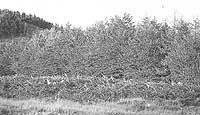Life as a refrigerant?
1989/10/01 Elhuyar Zientzia Iturria: Elhuyar aldizkaria
D. University of New York T. Schwartzman University and Howard Volk estimate that the Earth would have been 50ºC hotter if life had not developed. Life has kept the planet cold by meteorizing the silicates. Weathering removes carbon dioxide from the atmosphere, which causes the greenhouse effect.
According to scientists, when the Earth was young in the atmosphere there were many carbon oxides (IV). This caused the planet not to freeze. When 3.6 million years ago the first fossils appeared, the Sun was 20% colder than today. As the Sun warmed up, living organisms began to extract more and more carbon oxides (IV) from the atmosphere.
The key to the problem is whether during the development of earth temperature only the same point can be reached by physical weathering. To answer this question, Schwartzman and Volk analyze the Haguay basalt casts. The results obtained highlighted the role of living organisms in weathering.
According to his study, the decomposition of stone by chemical reactions occurs 100 times faster in lichen-coated stone than in red stones. Carbon oxide (IV) is involved in chemical decomposition and trapped in the soil.
Schwartzman and Volk initially describe the Earth as: 100ºC of temperature and compact atmosphere. The pressure kept the liquid water. The bacteria, by meteorizing the rocks, extracted carbon dioxide from the atmosphere and fixed it in the sea or in the form of carbonate. The planet cooled. As life increased the efficiency of the process increased and was able to compensate for the Sun's warming.

Gai honi buruzko eduki gehiago
Elhuyarrek garatutako teknologia





